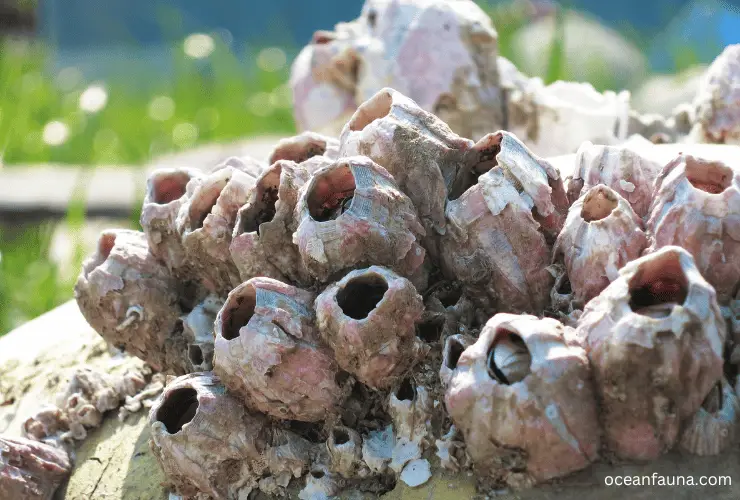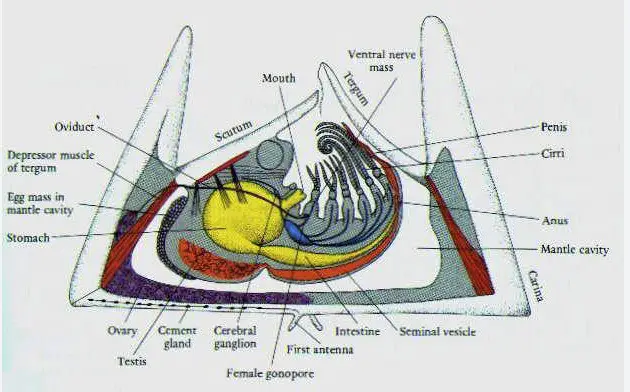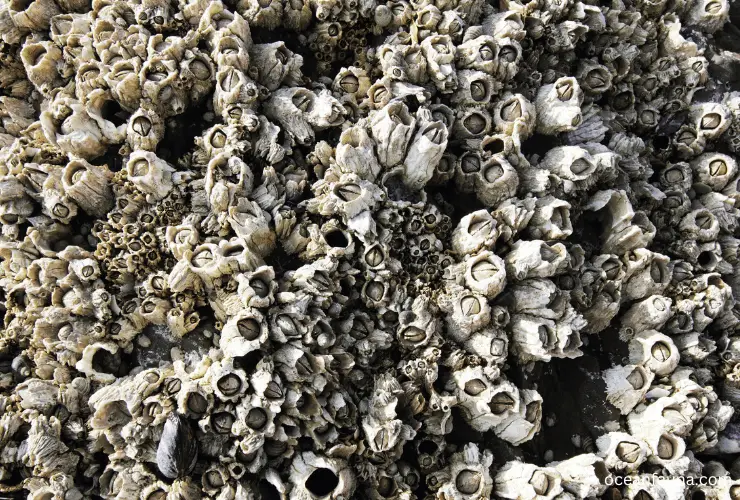A barnacle is a type of crustacean known as a cirripede. Its body is covered with tough plates made of calcium carbonate and attaches itself to hard surfaces to live. However, this article will let you know more about barnacle anatomy.
Barnacle Anatomy: External, Internal & Reproduction

Here are some anatomical systems of barnacles are discussed below.
External Anatomy
- Carapace: The exterior shell-like structure surrounding the body of a barnacle, consisting of a ring of plates, including the rostrum, two lateral plates, two carinolaterals, and a carina.
- Operculum: A lid-like structure covering the opening of the carapace in sessile barnacles.
Internal Anatomy
- Cirri: Hair-like structures extending from the barnacle’s body, used for feeding and locomotion.
- Thorax: The middle part of a barnacle’s body, consisting of various organs and tissues.
- Mantle Cavity: A space between the barnacle’s body and the carapace, containing the feeding and reproductive organs.
- Feeding Apparatus: Composed of the maxilla, labrum, and mandible, which help to capture and filter food from the surrounding water.
- Digestive System: Consisting of a stomach, intestine, and anus for breaking down and excreting waste.
Reproductive Anatomy
- Hermaphroditism: Most barnacles are hermaphrodites, meaning they have both male and female reproductive organs.
- Testes and Ovaries: Located in the mantle cavity and produce gametes for reproduction.
- Cement Glands: Secrete an adhesive substance for attaching to surfaces and forming colonies.
What is Cirri in Barnacle Anatomy?

Cirri are the feather-like appendages used by barnacles for feeding. These appendages are composed of specialized jointed legs modified for this purpose. There are six pairs of cirri in total, each equipped with sensory hairs that help detect the presence of microscopic organisms in the water.
The cirri of a barnacle are set within a protective shell structure, which is opened and closed by a series of muscles. When the barnacle is feeding, the cirri are rapidly extended and retracted through the opening at the top of the shell, combing the water for plankton and other small organisms.
At the anatomical level, cirri consists of a series of segments connected by joints. A hard exoskeleton, made up of chitin and other tough materials, covers these segments. The joint structure of the cirri allows them to be highly flexible, which is essential for effective feeding.
In addition to their joint structure, cirri are covered in tiny sensory hairs called setae. These hairs serve as receptors for detecting chemicals in the water, allowing the barnacle to locate potential food sources.
As the cirri moves through the water, the setae brush against small organisms, trapping them between the hairs until the barnacle can ingest them.
Do Barnacles Have Brains?
Yes, barnacles have brains. However, their brains are less developed than those of humans or other animals. Barnacles lived sedentary lives, so they didn’t require much cognitive power for survival.
In the cypris larva of the Balanus amphitrite, a common barnacle, the central nervous system includes a brain and a posterior ganglion. Though small, the cyprid’s nervous system, with up to 2000 neurons, is well-organized. It coordinates responses to settling cues.
A barnacle’s brain is at the front of its body, close to the antennae’s base. It’s so tiny that it’s almost invisible, but it’s crucial for sensing and reacting to the environment. The brain connects to several ganglia, which are nerve cell clusters. These ganglia coordinate the barnacle’s functions like feeding and reproduction.
However, brain size and complexity don’t always reflect intelligence or cognitive abilities. For instance, some tiny insects, despite their size, have advanced nervous systems for complex tasks.
Do Barnacles Have Eyes?
Yes, barnacles have eyes when they become adults. Each barnacle has just one eye situated at the center of its head. This eye, unlike human eyes, is simple. It has three photoreceptors to distinguish light from dark.
The main role of this eye is to detect sudden light changes, causing the barnacle to startle. This is known as the barnacle shadow reflex.
If the light dims suddenly, the barnacle stops its fishing activity. It then closes its opercular plates, a response to the reflex. But can barnacles see? Unlike human eyes, they can’t see shapes, movements, or colors. Their eye merely warns them of sudden light changes, like a passing shadow.
Even with its limited function, the barnacle’s eye is a great example of adaptation and evolution. It’s crucial for their survival, helping them avoid dangers and predators in their environment.
Do Barnacles Have a Heart?

Not exactly. Barnacles lack a true heart but have a basic blood system. They possess a sinus near the oesophagus that serves a similar purpose. This sinus, a fluid-filled cavity at the barnacle’s base, pumps blood around its body.
Muscle contractions near the sinus circulate the hemolymph, like blood in invertebrates. It transports oxygen, nutrients, and waste throughout the body. The barnacle’s sinus acts like a heart but isn’t one. It lacks the complexity and specialization of a true heart.
This sinus is a basic pump tailored to the barnacle’s unique physical needs. Although it’s not a heart in the traditional sense, it’s crucial for the barnacle’s survival and fits its simple physiology.
Do Barnacles Have Gills?
Barnacles don’t have gills. They get oxygen from water using their limbs and the inside part of their shells. In diffusion, molecules move from a crowded to a less crowded area. Barnacles use this method to take in oxygen.
Also, barnacles have special organs called maxillary glands for removing waste. These glands help barnacles stay clean by removing extra salt and waste. Barnacles are sessile; they stick to one place. So, their excretory system is crucial for their health.
Do Barnacles Have Stomachs?
Barnacles have a stomach inside their carapace, the tough shell protecting them. The stomach is on the barnacle’s underside. Its limbs also point downward.
Barnacles are arthropods belonging to the phylum Arthropoda. Arthropods have segmented bodies, jointed limbs, and tough skeletons known as carapaces. Their digestive systems usually have three parts: a foregut, midgut, and hindgut.
In barnacles, the mouth at the base of the carapace leads to a short oesophagus. Food then goes into the stomach, where its enzymes break it down. A barnacle’s stomach is specially adapted for its filter-feeding lifestyle. It can expand to hold much water, filtering out food particles like plankton.
After the stomach, food moves through the intestine, where nutrients are absorbed. Waste is then eliminated through the anus at the base of the carapace.
Do Barnacles Have Blood?
Yes, barnacles do have blood. Their blood is typically colorless and has no distinct red blood cells. But it has pigments that carry oxygen and turn blue when they get oxygen. When barnacle blood flows, it absorbs oxygen from water. This turns it blue.
After using the oxygen, the blood returns to the sinus for recirculation. Barnacle blood carries oxygen and moves nutrients, waste, and hormones. This blood also helps control the barnacle’s body temperature and immune responses.
FAQs
Are barnacles crustaceans?
Yes, barnacles are crustaceans belonging to the class Cirripedia in the phylum Arthropoda. Other examples of crustaceans include crabs, shrimp, and lobsters.
How long do barnacles live?
Barnacles typically have a lifespan of 10 years, although certain larger species can live up to 20 years. However, the exact lifespan varies based on species and environmental conditions.
Are barnacles intersex?
No. Barnacles are not intersex as of human means. But they are hermaphrodites.
As hermaphrodites, barnacles possess male and female reproductive organs, increasing their breeding success. However, barnacles differ from human intersex traits as they cannot operate both functions simultaneously. – Van Syoc
They adapt their roles based on environmental cues or conditions, showcasing their versatile approach to reproduction.
Can barnacles move?
The adult barnacles are sessile and can’t move, but some have limited mobility during their larval stage. They use specialized appendages called cyprids to swim and settle in a new location before undergoing metamorphosis into their adult form.
Interestingly, this limited mobility makes them susceptible to long-distance dispersal by ocean currents, allowing them to colonize new habitats and even cross geographical barriers.
Once settled, barnacles are firmly attached to their substrate using a powerful cement adhesive. This makes them highly resistant to wave action and other physical forces, ensuring their survival in harsh marine environments.
Conclusion
I hope you have comprehensive knowledge about the anatomy of barnacles. They possess an eye that detects light but cannot perceive images, a sinus that functions like a heart, limbs that absorb oxygen from the water, and maxillary glands that eliminate waste.
Although they don’t have true gills and hearts, they make up with their nervous system and other adaptations to survive in their aquatic environment.
To learn about these creatures, explore additional articles on our website or leave a comment with your questions below.

